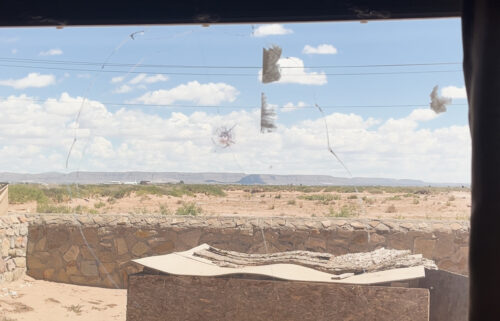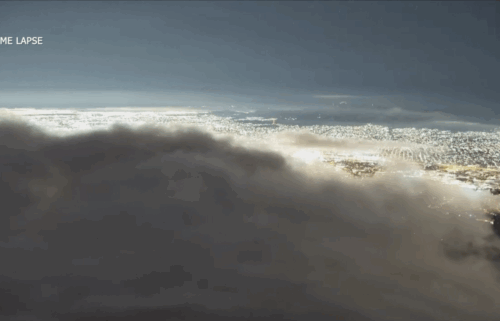NASA spacecraft will reveal first look at an asteroid, then slam into it
By Ashley Strickland, CNN
Get ready to see an asteroid’s tiny moon for the first time. Then, watch as a spacecraft deliberately crashes into it.
This scenario sounds like a sci-fi plot, but the NASA Double Asteroid Redirection Test, happening Monday, is a real-life mission. It aims to be humanity’s first attempt at deflecting an asteroid — without blowing it up, “Armageddon” style.
The spacecraft won’t obliterate Dimorphos, the moon orbiting the asteroid Didymos, but it’s large enough to leave an impact crater. If all goes well, DART will slightly change the motion of a celestial body in space in a stunning first.
The mission results could shape the way humans respond to any future space rocks with the potential to collide with the planet. Despite this extraordinary event taking place 6.8 million miles (11 million kilometers) away from Earth, we’ll get to see it play out in real time.
Defying gravity
Monday’s encounter will reveal Dimorphos in striking detail.
In the last hour before impact, expected to occur at 7:14 p.m. ET, DART’s camera will send back images at a rate of one per second, providing a live stream of its approach. Pinpricks of light will slowly come into focus as Didymos and Dimorphos take shape.
The surface of Dimorphos will get sharper and sharper. And when DART slams into the moon at 13,421 miles per hour (21,600 kilometers per hour), our view will disappear.
Wish you could see the collision from another perspective? The Italian Space Agency’s LICIACube will act as DART’s photojournalist, following behind the spacecraft and capturing images and video that will show the whole story.
Dino-mite!
Fossil eggs are providing insight into what life was like for dinosaurs before a massive asteroid strike wiped them out.
Researchers studied more than 1,000 fossilized dinosaur eggs recovered from the Shanyang basin in central China. The eggs came from only two groups, the toothless oviraptors and duck-billed hadrosaurs, suggesting low biodiversity.
It’s possible that dinosaur species were already struggling to survive about 66 million years ago as their diversity waned.
Other researchers still think the asteroid strike was the true driver of dinosaur extinction, not to mention a series of massive volcanic eruptions — and they suggest that if those cataclysmic events hadn’t happened, dinosaurs might still rule the planet.
Curiosities
Researchers in China have cloned a wild Arctic wolf. Sinogene Biotechnology unveiled the female wolf pup, named Maya, on Monday — and the Beijing-based company is hoping this method could save other species.
Wildlife conservationists consider the Arctic wolf, like the ones at Harbin Polarland in Harbin, China, pictured above, at low risk of extinction, but the climate crisis and human encroachment could change that.
To create Maya, scientists applied the same technique used in 1996 that led to Dolly the sheep, the first mammal cloned from an adult cell. The wolf pup was born from a surrogate beagle mother.
But some experts warn about the health and ethical concerns of controversial conservation efforts like cloning.
Across the universe
The James Webb Space Telescope’s new image of Neptune has showcased the most distant planet in our solar system and its hard-to-detect rings in a fresh light.
Webb also focused its instruments on the blinding light of Mars, one of the brightest objects in our night sky.
And don’t count out NASA’s InSight mission just yet. Despite gloomy predictions that the stationary lander would already have fallen silent on Mars, InSight is still operating. Listen to the sounds of space rocks crashing into Mars, as recorded by the lander.
Wild kingdom
Ever wondered what it might be like to experience the world as an animal?
Dogs socialize via scent, and eels discern their environment through electricity. Bats use echolocation to navigate.
All creatures live in their own “sensory bubble” called the umwelt, a species-specific reality that is crucial to their survival, according to award-winning science journalist Ed Yong.
You won’t want to miss this week’s episode of Chasing Life, a podcast hosted by CNN Chief Medical Correspondent Dr. Sanjay Gupta. He and Yong take you on a journey through the mysterious senses that exist in the animal kingdom.
And can you guess how many ants live on Earth? Scientists shared a new estimate this week, and it boggles the mind.
Take note
Don’t miss these highlights:
— The Artemis I mega moon rocket met all of its objectives during a crucial fueling test despite some leaks. But the rocket won’t launch Tuesday as planned due to concerns over Tropical Storm Ian.
— Cue the pumpkin spice and everything nice: Fall is finally here for those who live in the Northern Hemisphere. Drought might have an impact on the foliage colors, depending on where you live.
— Astronomers have uncovered more about the origin of a fast radio burst in space, along with new mysteries.
And keep an eye on the night sky because Jupiter will make its closest approach to Earth in 59 years on Monday, appearing bigger and brighter.
The-CNN-Wire
™ & © 2022 Cable News Network, Inc., a Warner Bros. Discovery Company. All rights reserved.
Like what you’ve read? Oh, but there’s more. Sign up here to receive in your inbox the next edition of Wonder Theory, brought to you by CNN Space and Science writers Ashley Strickland and Katie Hunt. They find wonder in planets beyond our solar system and discoveries from the ancient world.




